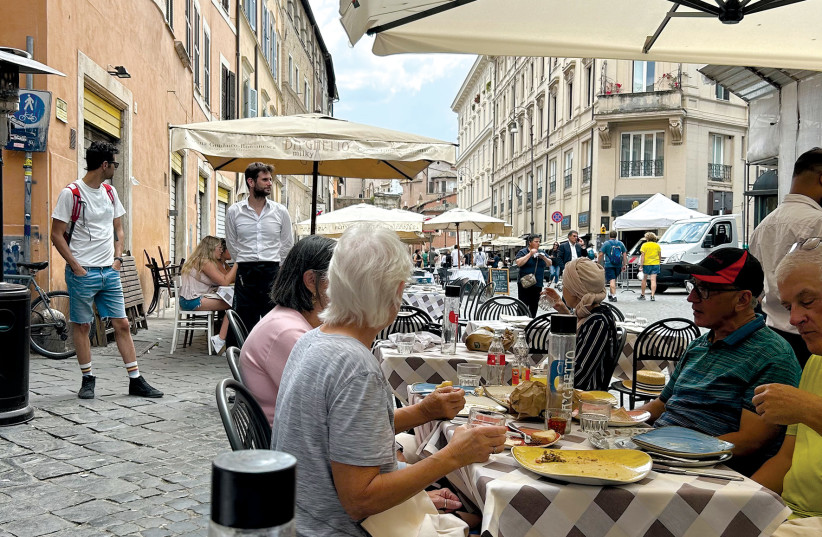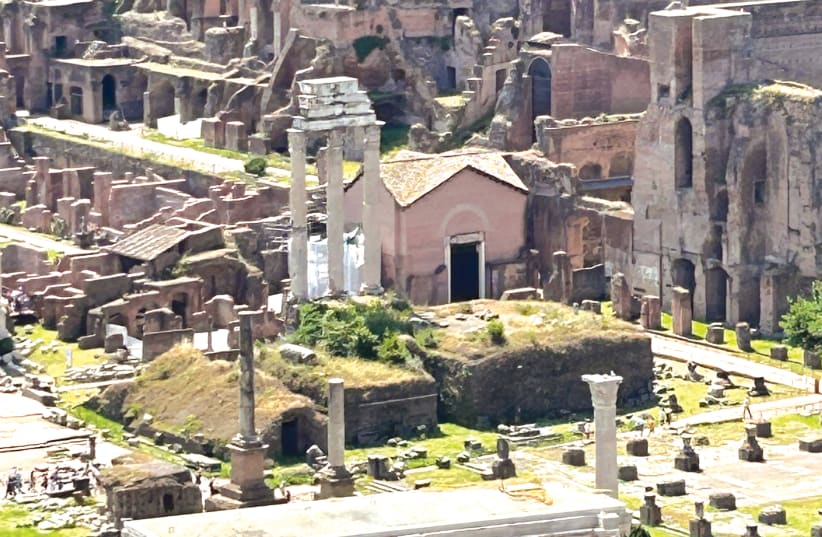
With the approaching fast of Tisha Be’av, I was reminded of a momentous visit to Rome in 2017. My wife and I stayed at My Guest Roma, a guest house owned by a wonderful Roman Jew, Stefano Milano. Like most travelers these days, we discovered him by chance on the Internet. From the very beginning, Stefano was incredibly helpful. His family roots run deep in Italy. His father’s family moved out of Rome’s Jewish ghetto in the late 19th century, having suffered decades of discrimination and persecution. A few weeks ago, we decided to revisit Rome. We went back to the neighborhood of Nomentana, where we reconnected with Stefano, who welcomed us warmly.
Rome’s Jewish community represents the oldest Diaspora in Europe and goes back 2,200 years. Jews first settled in Rome not because they were enslaved but because of the thriving economy of the city in ancient times. According to Philo, Rome’s Jewish population only grew in the middle of the first century BCE. Most of the Jews arrived as slaves in the wake of Pompey’s conquest of the Hasmonean kingdom in 63 BCE. The next wave of Jews arriving in Rome took place after the destruction of the Second Temple, when thousands of Jewish slaves were brought to Rome and paraded through the Arch of Titus, which still stands today in the ruins of the Roman Forum next to the Colosseum. The tragedy of this Second Temple exile is marked by a custom that decrees that no Jew should ever walk under Titus’s infamous arch. Intriguingly, Stefano explained to us that on Tisha Be’av, until the present day, the Jews of Rome go to the Arch of Titus and deliberately walk through it in the opposite direction, away from the city, in a gesture of defiance, to show their pride at being liberated from slavery, discrimination, and humiliation.
In a recent series of fascinating lectures by Prof. Kenneth Stow sponsored by Beit Avi Chai, Stow explained that Jews who merited Roman citizenship were treated fairly. Both Julius and Augustus Caesar supported the Jewish community. Synagogues were classified as colleges to get around Roman laws banning secret societies, and the synagogues were allowed to collect the yearly tax paid by all Jewish men for synagogue maintenance.
What happened to the Jews of Rome?
Italy began to experience an economic and social decline as the 16th century progressed. Not long afterwards, problems for the Jews began in 1555. Up until then, the population of Jews in Rome had increased due to immigration, particularly from the Sephardi Jews who were expelled from Spain and Portugal. The Jews chose to establish themselves in an area of Rome near the fish market near the Tiber River. Initially they were not restricted to living in any specific place until Pope Paul IV’s decree. He, together with his Christian cohorts, believed that the Jews were impure because they had not accepted Christianity as their faith. As a result, the Rome and Ancona ghettos, together with others, were established in the papal states through the papal bull Cum Nimis Absurdum, promulgated by Pope Paul IV on July 14, 1555. All Jews in Rome were forced to move into the ghetto, where for the next 350 years they struggled to survive financially and physically. The ghetto is situated near the Tiber River, which floods every spring, bringing with it unhygienic conditions and poor sanitation, rendering the ghetto almost uninhabitable. The Jews had to abandon their professions and trades and were restricted to doing only menial work such as mending clothes and textiles and trading secondhand clothing. Stefano Milano’s ancestors had been forced to live in the ghetto.
“Conditions were horrendous,” he told me. “There was no space. An entire family was crammed into one room. The ghetto had three gates which were locked at night and opened in the morning.”


Throughout the time that the Jews lived in the ghetto, five synagogues were created, all in the same building. Thus evolved the nusach of Bnei Roma, whose liturgical rites are the closest to those practiced in the Land of Israel. Today, the Great Synagogue in Rome, known as the Tempio Maggiore, continues the tradition of the Bnei Roma, and the same prayers are recited with few changes. In modern-day Rome, the ghetto has become one of the most visited sites in the city. In 1888, the ghetto walls were torn down, and the ghetto itself was almost completely demolished. In 1904, the Great Synagogue of Rome and a number of apartment buildings were erected on the site. Embankments were created to prevent flooding and reduce the spread of disease.
The Roman ghetto was the last remaining ghetto in Western Europe until ghettos were reintroduced by Nazi Germany in the 1930s.
Today, it has been transformed into an elegant neighborhood, famous for its boutiques and galleries, with many kosher and kosher style restaurants offering authentic Roman Jewish cuisine for tourists to dine indoors or al fresco. Following a large influx of Libyan Jews to Rome in 1967, there are now approximately 15,000 Jews in the capital. The ghetto has become a charming nexus of Jewish life with its own JCC, Jewish school, and recreation center set against the backdrop of the ancient theatre of Marcellus.
The gradual emancipation of the Jews of Rome began in the time of Napoleon. They were freed from the ghetto in 1870. Despite the severe restrictions, Stefano’s maternal family, the Alatris, distinguished themselves as textile merchants. Unusually, they were granted permits which allowed them to come and go from the ghetto.
“After the ghetto was torn down, my family and other Jewish families moved to the Monti neighborhood not far from the Colosseum. In the 1930s, when Mussolini came to power, he ordered the demolition of the neighborhood and the building of the white Victor Emmanuel monument, clearing the way to allow majestic views of the Forum and the Colosseum and Rome’s Imperial heritage.” Stefano then explained how a few Jewish families decided to build homes for themselves in the Nomentana district, which was on the outskirts of the city in those days.
In October 1943, the Jews faced a new threat when the Nazis and the Fascists began to round up members of the community.
“They had gotten hold of written records listing all the names and addresses of Jewish families. My father and his parents went into hiding; however, my maternal grandparents, the Alatris, were not so lucky. My great-grandfather was from an important family. He was caught trying to help someone move his building equipment into a warehouse. They knew he was Jewish, and he was fined one million lira, the equivalent of a million euros today. He paid the fine in exchange for his life and his release. Not long afterwards, he and his family were deported to Germany and then to Auschwitz, where they were murdered. He managed to write a letter explaining what was happening to him and his family. Amazingly, the letter reached the person to whom it was addressed, and we still have the letter,” Stefano recounted.
While he was talking to me, I noticed a small bust of a Victorian-looking gentleman on the shelf behind him. Curiosity got the better of me, and I asked him about the object. He explained that it was the bust of Samuele Alatri, one of his ancestors. He was a politician, communal worker, and orator. “For more than 60 years, he led the Jewish community of his native city and bore the brunt of its struggle for religious and personal freedom.” Stefano told me. “He was one of the men who, after a plebiscite, officially went to inform King Victor Emanuel II that Rome was going to join the unified Italian state.”
In my research for this article, I found the following: The services rendered by Alatri to his native city were acknowledged by the syndic (governor) of Rome, who at Alatri’s funeral said: “The city of Rome loved him like a father, and now she mourns his death like that of a father.”
I asked Stefano what it was like growing up as a Jew in Rome.
“When I was a child, my father used to take me to a local church on Easter Sunday. I could not understand why he wanted me, a Jewish child, to attend mass. In the 1970s, Pope John XXIII issued a declaration from the Vatican decreeing that the Jews did not kill Christ. Shortly afterwards, the pontiff, while passing Rome’s Great Synagogue, noticed the worshipers leaving the building after prayer services. He stopped his car and went out to bless them. My father did not believe that antisemitism had left the Catholic church. He took me to the Easter prayer services on Easter Sunday to hear the priests spewing out their antisemitic tropes, which had not altered despite the pope’s attempts to change things. Although we Jews are told not to enter Catholic churches, for us it was important to be aware of what was really going on in order to protect ourselves and our community.”
I was interested to know what made Stefano enter the kosher hospitality and tourism business. “Before starting this enterprise, I used to be a restorer of old furniture. In the early 2000s, I realized that there was a gap in the market vis-à-vis catering to observant Jews and their families who were visiting Rome. I decided to adapt the building and offer kosher bed and breakfast facilities for Jewish travelers,” he explained.
My Guest Roma welcomes Jews and non-Jews alike. For the former, staying at the B&B is often their first exposure to the unique Italian variety of Jewish life. For the latter, it is often their first encounter with Jews and Judaism. Stefano’s hospitality and generosity know no bounds. When we arrived as guests a few weeks ago, he greeted us warmly but then explained how difficult things had been for him and his family. He had just returned from shul after saying Kaddish for his young wife, Dalida, on her first yahrzeit.
“Within one year I have lost my dear wife to cancer and my brother, who passed away in hospital after contracting corona. It has been extremely difficult, and it is now my duty to take care of my elderly parents who still live in this building,” he said.
Despite these sad events, Stefano Milano remains dedicated to his family and to his guests. Our experiences of visiting Jewish Rome would never have been the same without his gracious hospitality. ■
My Guest Roma’s email and phone contact are: info@myguestroma.com and +39 349 3556758.
